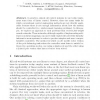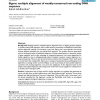5 search results - page 1 / 1 » Evolving Genes to Balance a Pole |
EUROGP
2010
Springer
13 years 10 months ago
2010
Springer
We discuss how to use a Genetic Regulatory Network as an evolutionary representation to solve a typical GP reinforcement problem, the pole balancing. The network is a modified ver...
ICANN
2005
Springer
13 years 10 months ago
2005
Springer
Abstract. In practice, almost all control systems in use today implement some form of linear control. However, there are many tasks for which conventional control engineering metho...
GECCO
2005
Springer
13 years 10 months ago
2005
Springer
In neuroevolution, a genetic algorithm is used to evolve a neural network to perform a particular task. The standard approach is to evolve a population over a number of generation...
CF
2007
ACM
13 years 8 months ago
2007
ACM
In the life sciences, genomic databases for sequence search have been growing exponentially in size. As a result, faster sequencesearch algorithms to search these databases contin...
BMCBI
2006
13 years 4 months ago
2006
Background: Existing tools for multiple-sequence alignment focus on aligning protein sequence or protein-coding DNA sequence, and are often based on extensions to Needleman-Wunsch...


